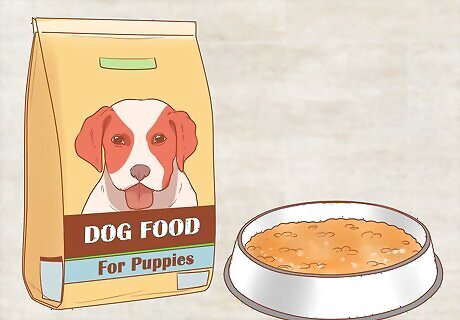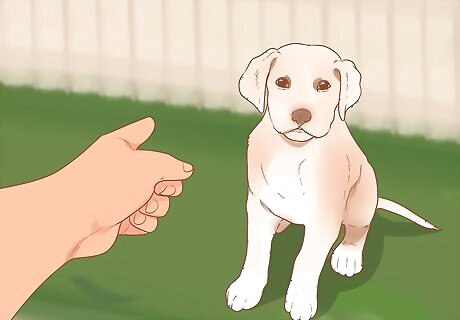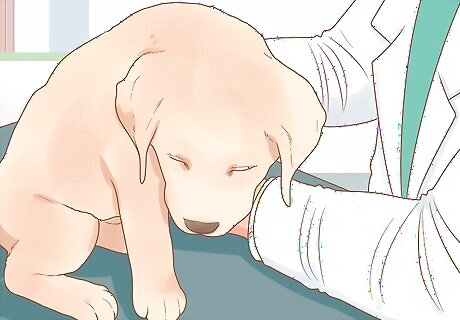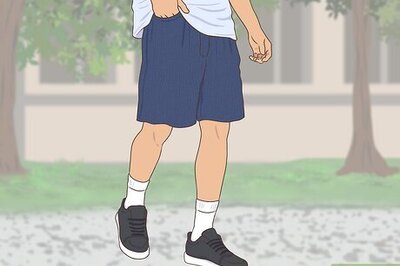
views
X
Trustworthy Source
American Kennel Club
The American Kennel Club (AKC) is a purebred dog pedigree registry in the United States. The AKC advocates for the responsible ownership of dogs and promotes purebred dog events, such as the Westminster Dog Show.
Go to source
Buying Supplies Before Bringing a Puppy Home

Buy a collar, leash, and tags for your new puppy. When you pick up your new Lab, have these things already. Having them already will ensure that you can put tags on your puppy right away and can control its movement. This reduces the risk of it getting lost and not making it back to you. Dog collars, tags, and leashes are available at all pet stores and from online retailers. Your puppy's tags should include its name, your name, your phone number, and your address.Tip: Pick out a collar that is the right size for your puppy right now. Don't pick a collar that is a bit too big so that the dog can grow into it. This will result in a collar that is too loose. Just accept that as the dog grows, you will need to replace its collar with a bigger one.

Set up a bed and crate, if necessary, for your puppy. When you bring your puppy home, you should have a spot for it to sleep all set up. There should be a comfy, warm bed for it to sleep in. If you plan on crate training your Lab, put the bed in the crate so the puppy gets used to it. Pick out a spot where you want the bed or crate to be permanently. Your puppy will get used to whatever spot you first put these things, so make sure that it is permanent. Choose a spot that is out of the way, so that the puppy isn’t underfoot. It’s also important to select an area where your puppy won’t feel isolated from the rest of the family. A corner of the living room is a good choice.

Pick out fun and exciting toys. In order to keep your puppy busy, you want to give it a variety of items that it can play with. Toys are especially important for keeping its mind occupied when you are not around. Make sure to choose dog-safe toys that are appropriate for your puppy’s age and size, and pick items that your puppy can’t easily swallow. Some different types of toys you might consider include: Chew toys Puzzle toys Squeaking toys Tugging toys Plush toys

Buy a variety of other supplies you might need. Taking care of your Lab puppy can take a lot of miscellaneous supplies. Some items you may consider buying before you bring your puppy home include: Food and water dishes Baby gates to keep your puppy contained, if necessary Poop bags Pee pads Grooming wipes Surface cleaner made specifically for cleaning urine or feces
Feeding Your Puppy

Purchase the puppy food that your puppy is already eating. When you bring a new puppy home, it's important to keep feeding it the same food that it has been eating at its previous home. Suddenly changing your puppy’s food can imbalance its gut bacteria, leading to an upset stomach or other digestive issues. Talk to the person or organization that you are adopting your puppy from to see what food they are feeding it. They should willingly provide that info and they may even send you home with some if you can't find any to buy. If you can't find the right food in your local pet supply store, consider ordering it online. However, you would need to order it ahead of time so that you have it on hand when the puppy comes home.

Transition the puppy's food gradually. If you want to feed your puppy a different food from what it has been eating, you will need to switch its food over the course of several days. Begin by combining about 25% of the new food into 75% of the old food. Feed that mix for several days. Then change the food to a 50/50 mix of old and new. After 1-2 weeks of that, do 75% of the new food and 25% of the old food for 1-2 weeks. Finally, you can give the puppy all new food. If you are content to give your puppy the food it was originally eating, it's fine to do that.

Talk to your vet about what and how much to feed your puppy. Every puppy will have different nutritional needs. Because of this, it's a good idea to discuss proper nutrition with your vet. They can suggest great foods to give your puppy and how much it should be eating. The right portion size depends on the size of your puppy and its metabolism. Ask your vet to teach you how to body score your puppy. This will allow you to do a quick visual check to see whether your puppy is losing or gaining weight. You can then adjust your puppy’s diet accordingly.Tip: If your vet suggests a specific food but doesn't tell you how much to give your puppy, follow the instructions on the packaging.

Feed your puppy multiple times each day. Doing 3 or 4 feedings per day allows your puppy to get enough nutrients without overwhelming its digestive system with a huge amount of food at once. This is especially important when your puppy is under 6 months old, as they have delicate systems. Don't just leave the food out all day. Take the food away after the puppy eats for about 10 or 15 minutes.

Provide fresh water at all times. Lab puppies should always have access to fresh water so that they can stay adequately hydrated. Put out a dish of water and dump it out, clean the dish, and refill it daily. Some puppies are really messy with their water dishes. To prevent a mess, try putting the water dish on a tray, so that spilled water won't go right onto the floor.
Training Your Puppy

Begin house training your puppy right away. When you bring your puppy home, you will need to teach it to go to the bathroom outside. This is done by taking it out on a regular basis 24 hours a day until the puppy understands that it only goes to the bathroom outside. During training, take your puppy outside every 20 or 30 minutes and give it a chance to relieve itself. If your puppy does go while you’re outside, make sure to give it plenty of praise. As a rule of thumb, a puppy can hold its urine for the length of its age in months, plus 1 hour. So, for example, an 8-week-old puppy can generally hold its bladder for a maximum of 3 hours (including overnight). When taking your puppy outside, take it to the same spot every time. Going to the same spot and having it smell like feces and urine will gradually let your puppy know that this is the right spot to go to the bathroom.Tip: House training is a gradual process that will likely include accidents. Don't get mad at your puppy if it goes to the bathroom in the house. Simply clean it up and adjust your schedule to take it out more often.

Start socializing your puppy as soon as possible. Your puppy needs daily interactions with people, as well as other animals. Take your puppy to public places where it can have positive interactions with strangers. Once your puppy is vaccinated, you can also take it to places where other dogs are, such as a dog park. If you don’t do this, your puppy will become insecure and will not like being around new people and animals. This can result in your dog biting guests or being aggressive.

Begin doing basic obedience training. From the moment you bring your Lab puppy home, you can set the groundwork for training. Training is most effective when done with positive reinforcement. This means that when the puppy does something you want it to, you say a word cue to associate with the action and give the puppy a treat at the same time. This will encourage your puppy to learn and do specific actions when requested. For example, when taking your puppy on a walk, say the word "sit" any time your puppy naturally sits down. Give a treat right when the action happens as well. Gradually, your puppy will learn that the word is associated with the action and, if it does that action when asked, it will get a treat. Training a puppy is hard work, and it requires commitment and consistency. Know what you want it to learn and how you want it to respond to your commands before you dive in, so that you don't have to switch your approach later on (and confuse it!).
Spending Time with Your Puppy

Exercise your puppy every day. Lab puppies have a lot of energy and they need to use that energy or they get into trouble. To avoid having items in your home chewed up and to keep your Lab's body healthy, your puppy should be allowed to walk and run around for at least an hour every day. This exercise can include a variety of activities, including walks, runs, and games, such as tug-o-war. It's best to break this hour of activity into several sessions of play and exercise. For example, you can take your puppy for a walk in the morning and have a long play session in the evening. Extensive exercise and daily playtime will help ensure that your puppy doesn’t become overweight. It will also help keep the puppy happy and good natured.Tip: There is such a thing as too much exercise for a puppy. If your puppy looks tired, is panting, or is reluctant to continue with an activity, let the dog rest.

Spend quality time petting and snuggling with your puppy. Labs are happiest when they are with people, so make sure you can spend time with your puppy. This could be just letting it curl up in your lap or petting it while it lounges next to you. However, since Labs are such active dogs, your puppy will be extra happy if it's getting one-on-one time playing or going on adventures. Puppies that are not given a lot of attention can act out and misbehave. They also need to get used to spending time alone, however. Give your puppy a few hours of designated alone time each day to prevent separation anxiety.

Teach your puppy tricks and games, such as fetch. The goal is to pick things that will stimulate your dog's mind at the same time as exercising its body. Labs are particularly good at playing fetch and other retrieving games. However, there are a wide variety of activities they can do, so try a bunch and see what you and your puppy like to do best. For example, some Labs enjoy catching a Frisbee or running through obstacle courses.
Keeping Your Puppy Healthy

Have your new puppy looked over by a vet. When you bring a new puppy home, have it assessed by a veterinarian as soon as possible. Your vet will look the animal over and tell you if it needs any medical care. During the exam, the vet will test its blood and feces and assess its physical condition. The vet will make sure your dog has clear, shiny eyes that are free from discharge. They will also make sure that the puppy’s coat is glossy, with a little flaking skin. The vet may also play with your puppy a bit to ensure that it is alert and playful. A puppy that is not alert and playful may have a medical problem that is causing it to be fatigued and uncomfortable. After its initial visit, take your puppy to the vet once a year to make sure that it is healthy and strong. In the yearly exam, your vet will do a thorough check-up to look for diseases and other problems that might be popping up.

Ask your vet to check for illnesses common to Labs. There are a variety of conditions that Labs commonly get and it's important to assess whether your puppy has any of them. These include hip dysplasia, heart disorders, muscle weakness, exercise-induced collapse (EIC), bloat, and eye conditions. During regular checkups, make sure that your vet is on the lookout for these problems as your dog gets older so that they can be treated quickly if they arise. Many of these conditions will not become obvious until your dog is fully grown. During early vet checks, your vet will primarily focus on making sure your puppy’s heart is healthy and that it is free from parasites and infectious diseases. Some of these conditions, such as bloat, can be largely avoided with proper care. However, there are other conditions that are genetic and can only be avoided with good breeding habits, such as EIC.

Begin immunizations and pest prevention as soon as possible. There are a variety of communicable illnesses that your puppy could get if it's not immunized. Your veterinarian will give your puppy its first shots when it is about 6 to 8 weeks old. This round of immunizations will be for distemper, measles, and parainfluenza. You vet will also give you medications to apply on your puppy monthly to prevent pests and parasites, such as fleas, ticks, and heartworms. Your puppy will then need several more rounds of shots and continual pest and parasite prevention as it gets older. Your veterinarian will let you know the proper schedule for your puppy's immunizations. Be sure to follow this schedule closely so that your puppy's health is protected.Tip: Several types of immunizations, such as the one for distemper, require several rounds of shots. Getting just one round will not protect your puppy's health fully.

Keep your puppy's teeth and gums healthy. Start brushing your puppy's teeth when it is a small puppy so that it is used to the procedure as it grows up. Brushing from an early age will help keep your dog's teeth and gums healthy into old age. Use a toothbrush and toothpaste that is made specifically for dogs. These are available at most pet stores and from online retailers.
Grooming Your Puppy

Brush your puppy's coat at least once a week. Brushing your puppy will help clean out its coat and prevent the fur from becoming knotted, and it's a time to bond with your puppy. Simply get a fine-toothed grooming comb or brush and go over the puppy's entire body with it. Brushing your Lab puppy often will ensure that it is used to being touched by people as it grows up. This will help make the dog more personable and will make future grooming easier.

Have your puppy's nails trimmed on a regular basis. Listen to your puppy as it walks on hard surfaces. If you can hear the nails clicking on the ground a lot, it's time for a trim. You can either trim the nails yourself or have a professional groomer do it. Either way, having trimmed nails will allow your puppy to walk and run easier. The biggest thing to watch out for when trimming your own puppy's nails is to avoid cutting into the quick of each nail. The quick is the live center of the nail that has blood flowing through it and that can be painful for the dog if it is cut. Only cut off the very tip of each nail to avoid injuring the dog while trimming. If you decide to cut your puppy's nails yourself, make sure you have styptic powder on hand to stop any accidental bleeding. Ideally, the puppy's nails would be naturally worn down as it walks on concrete or other hard surfaces. However, this is not always what happens.

Give your puppy a bath if it gets very dirty. Lab puppies don't usually need a bath on a regular schedule. However, if you notice your puppy is stinky or is physically dirty, feel free to bathe it. Use a soap or shampoo that is made specifically for bathing puppies. The ingredients will be specially formulated to work with a dog's skin and fur. Bathing a puppy starting at a young age will help get it used to baths as it gets older. This will make bathing your dog as it gets physically bigger much easier.Tip: It can take some effort to keep a puppy contained in the bath. Try putting a squeaky toy in the tub to keep your puppy entertained while it is being scrubbed.



















Comments
0 comment